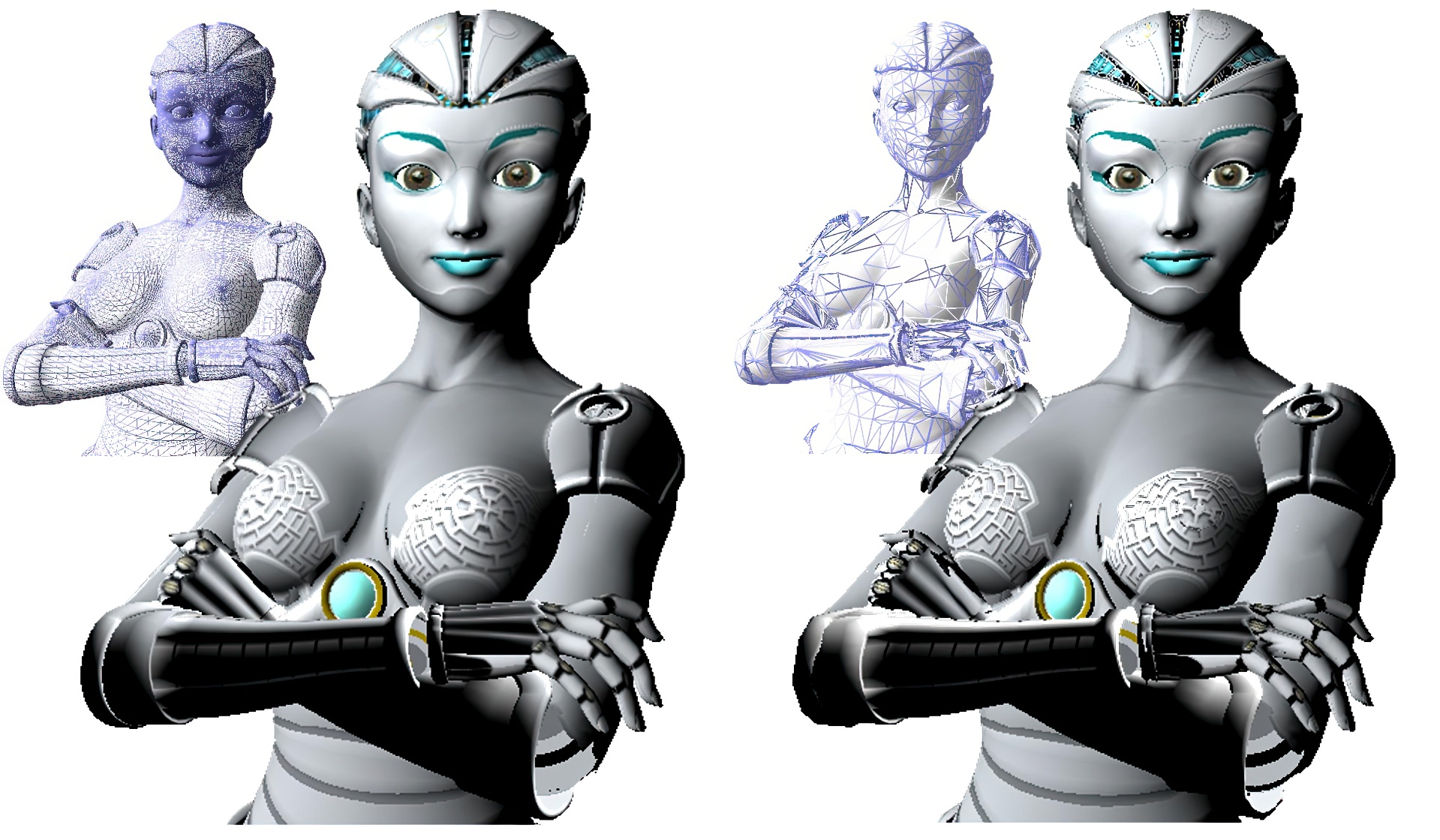“IGT: inverse geometric textures”
Conference:
Type(s):
Title:
- IGT: inverse geometric textures
Session/Category Title: Texture
Presenter(s)/Author(s):
Abstract:
Preserving details from a high resolution reference model onto lower resolution models is a complex, and sometimes daunting, task as manual intervention is required to correct texture misplacements. Inverse Geometric Textures (IGT) is a parameterization-independent texturing technique that allows preservation of texture details from a high resolution reference model onto lower resolutions, generated with any given simplification method. IGT uses a parameterization defined on the reference model to generate an inversely parameterized texture that stores, for each texel, a list with information about all the triangles mapped onto it. In this way, for any valid texture coordinate, IGT can identify the point and the triangle of the detailed model that was projected, allowing details from the reference model to be applied onto the fragment from the low-resolution model. IGT is encoded in compact data structures and can be evaluated quickly. Furthermore, the high resolution model can have its own independent artist-provided, unmodified parameterization, so that no additional effort is required to directly use artist-designed content.
References:
1. Carr, N. A., and Hart, J. C. 2002. Meshed atlases for real-time procedural solid texturing. ACM Trans. Graph. 21, 2, 106–131. Google ScholarDigital Library
2. Chen, C.-C., and Chuang, J.-H. 2006. Texture adaptation for progressive meshes. Computer Graphics Forum 25, 3, 343–350.Google ScholarCross Ref
3. Cignoni, P., Montani, C., Scopigno, R., and Rocchini, C. 1998. A general method for preserving attribute values on simplified meshes. In VIS ’98: Proceedings of the conference on Visualization ’98, IEEE Computer Society Press, 59–66. Google ScholarDigital Library
4. Cignoni, P., Montani, C., Rocchini, C., Scopigno, R., and Tarini, M. 1999. Preserving attribute values on simplified meshes by resampling detail textures. The Visual Computer 15, 10, 519–539.Google ScholarCross Ref
5. Cohen, J., Olano, M., and Manocha, D. 1998. Appearance-preserving simplification. Computer Graphics (Proc. SIGGRAPH) 32, 115–122. Google Scholar
6. Garland, M., and Heckbert, P. S. 1997. Surface simplification using quadric error metrics. Computer Graphics (Proc. SIGGRAPH) 31, 209–216. Google Scholar
7. Garland, M., and Heckbert, P. S. 1998. Simplifying surfaces with color and texture using quadric error metrics. In VIS ’98: Proceedings of the conference on Visualization ’98, IEEE Computer Society Press, 263–269. Google ScholarDigital Library
8. Giegl, M., and Wimmer, M. 2007. Unpopping: Solving the image-space blend problem for smooth discrete lod transitions. Computer Graphics Forum 26, 1 (Mar.), 46–49.Google ScholarCross Ref
9. Gu, X., Gortler, S. J., and Hoppe, H. 2002. Geometry images. ACM Trans. Graph. 21, 3, 355–361. Google ScholarDigital Library
10. Hoppe, H. 1996. Progressive meshes. Computer Graphics (Proc. SIGGRAPH) 30, 99–108. Google Scholar
11. Hoppe, H. H. 1999. New quadric metric for simplifying meshes with appearance attributes. In IEEE Visualization ’99, D. Ebert, M. Gross, and B. Hamann, Eds., 59–66. Google Scholar
12. Hormann, K., Lévy, B., and Sheffer, A. 2007. Mesh parameterization: Theory and practice. In SIGGRAPH 2007 Course Notes, ACM, 1–122. Google Scholar
13. Kajiya, J. T., and Kay, T. L. 1989. Rendering fur with three dimensional textures. Computer Graphics (Proc. SIGGRAPH) 23, 271–280. Google ScholarDigital Library
14. Lacoste, J., Boubekeur, T., Jobard, B., and Schlick, C. 2007. Appearance preserving octree-textures. In GRAPHITE ’07: Proceedings of the 5th international conference on Computer graphics and interactive techniques in Australia and Southeast Asia, ACM, 87–93. Google Scholar
15. Lee, C. H., Varshney, A., and Jacobs, D. 2005. Mesh saliency. ACM Trans. Graph. 24, 3, 659–666. Google ScholarDigital Library
16. Lefebvre, S., and Hoppe, H. 2006. Perfect spatial hashing. In SIGGRAPH ’06: ACM SIGGRAPH 2006 Papers, 579–588. Google Scholar
17. Lévy, B., Petitjean, S., Ray, N., and Maillot, J. 2002. Least squares conformal maps for automatic texture atlas generation. ACM Trans. Graph. 21, 3, 362–371. Google ScholarDigital Library
18. Lofsted, M., and Akenine-Moller, T. 2005. An evaluation framework for ray-triangle intersection algorithms. Journal of Graphics Tools 10, 2, 13–26.Google ScholarCross Ref
19. Mootools, 2007. Polygon cruncher. http://www.mootools.com/.Google Scholar
20. Nehab, D., and Hoppe, H. 2007. Texel programs for random-access antialiased vector graphics. Technical Report MSR-TR-2007-95, Microsoft Research.Google Scholar
21. Orgaz, S., 2007. xnormal. http://www.xnormal.net/.Google Scholar
22. Policarpo, F., Oliveira, M. M., and Jo a. L. D. C. 2005. Real-time relief mapping on arbitrary polygonal surfaces. In I3D ’05: Proceedings of the 2005 symposium on Interactive 3D graphics and games, 155–162. Google Scholar
23. Porumbescu, S. D., Budge, B., Feng, L., and Joy, K. I. 2005. Shell maps. ACM Trans. Graph. 24, 3, 626–633. Google ScholarDigital Library
24. Sander, P. V., Snyder, J., Gortler, S. J., and Hoppe, H. 2001. Texture mapping progressive meshes. Computer Graphics (Proc. SIGGRAPH) 35, 409–416. Google Scholar
25. Sander, P. V., Wood, Z. J., Gortler, S. J., Snyder, J., and Hoppe, H. 2003. Multi-chart geometry images. In SGP ’03: Proceedings of the 2003 Eurographics/ACM SIGGRAPH symposium on Geometry processing, Eurographics Association, 146–155. Google ScholarDigital Library
26. Sheffer, A., Lévy, B., Mogilnitsky, M., and Bo-gomyakov, A. 2005. Abf++: fast and robust angle based flattening. ACM Trans. Graph. 24, 2, 311–330. Google ScholarDigital Library
27. Sorkine, O., Cohen-Or, D., Goldenthal, R., and Lischinski, D. 2002. Bounded-distortion piecewise mesh parameterization. In Proceedings of IEEE Visualization, IEEE Computer Society, 355–362. Google ScholarDigital Library
28. Tarini, M., Cignoni, P., and Scopigno, R. 2003. Visibility based methods and assessment for detail-recovery. In VIS ’03: Proceedings of the 14th IEEE Visualization 2003 (VIS’03), IEEE Computer Society. Google Scholar
29. Tarini, M., Hormann, K., Cignoni, P., and Montani, C. 2004. Polycube-maps. ACM Trans. Graph. 23, 3, 853–860. Google ScholarDigital Library
30. Zhou, K., Synder, J., Guo, B., and Shum, H.-Y. 2004. Iso-charts: stretch-driven mesh parameterization using spectral analysis. In SGP ’04: Proceedings of the 2004 Eurographics/ACM SIGGRAPH symposium on Geometry processing, 45–54. Google Scholar





